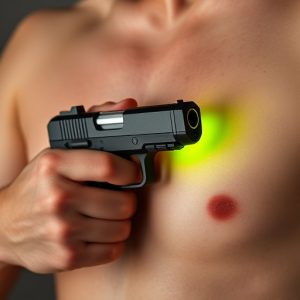Stun Gun Skin Contact Necessity: Efficacy Explored
Stun guns are self-defense tools that incapacitate attackers by delivering a high-voltage electric …….
Stun guns are self-defense tools that incapacitate attackers by delivering a high-voltage electric current. They traditionally require direct contact with the skin for optimal effectiveness due to the body's conductive properties, but recent advancements have improved their ability to work through light clothing. The strength of the shock must be carefully calibrated to be effective yet safe. It's a common misconception that stun guns must always touch skin; modern designs can overcome this limitation. Users should be well-informed about the technology, as environmental factors and proper usage are critical for their effectiveness in self-defense scenarios. Additionally, individuals considering non-lethal defense options should also understand the mechanics of chemical sprays and kubotan keychain weapons, which offer alternative solutions. Knowledge of local laws regarding these devices is equally important, ensuring legal compliance and safe application in emergency situations. Understanding the science behind stun guns and related self-defense mechanisms is essential for users to effectively utilize them for protection.
When considering non-lethal self-defense devices, stun guns emerge as a prominent choice. A common query arises regarding their efficacy: Does a stun gun have to touch skin to be effective? This article delves into the critical aspects of stun gun operation and the necessity of skin contact for optimal performance. We will explore the scientific principles that govern their function, alternative methods for deploying them effectively, and the nuances surrounding their use in various scenarios. Understanding these elements is crucial for anyone considering a stun gun as a means of personal protection.
Understanding Stun Gun Efficacy and Skin Contact Requirements
Stun guns are non-lethal electroshock weapons that incapacitate individuals by delivering a high-voltage, low-current electrical shock. The efficacy of a stun gun is closely tied to its proper deployment, which includes making skin contact with the target. While the device does not necessarily need to adhere to the skin for an extended period, direct skin contact significantly increases the likelihood of an effective stun. This is because the conductive prongs or electrodes must have a clear path to transmit the electrical current. When a stun gun touches skin, the body’s natural moisture and resistance serve as an optimal conductor, allowing the electric charge to effectively disrupt muscle function and cause disorientation or temporary paralysis. Understanding this requirement is crucial for individuals who carry stun guns for self-defense; failure to establish proper contact may result in a less effective stun, potentially compromising safety. It’s also important to note that environmental factors such as humidity, temperature, and the presence of insulating materials can influence the device’s performance. Therefore, users should familiarize themselves with these conditions to ensure the stun gun operates as intended when needed.
The Science Behind Stun Guns and Alternatives to Direct Contact
Stun guns are electronic devices designed to incapacitate an attacker by delivering an electric shock, which can be disorienting and debilitating. The effectiveness of a stun gun does not necessarily depend on direct contact with the skin; it functions through the delivery of a high-voltage, low-ampere electrical current. This current disrupts the normal function of the muscular and nervous systems of the target individual. The charge is typically delivered via probes or prongs that can be pressed against an individual, although the term “touch” can encompass this proximity when discussing the device’s operation. The intensity of the shock is critical; it must reach a certain threshold to be effective without causing permanent harm.
When considering alternatives to direct skin contact for stun guns, one should explore conductive materials and the principles of electromagnetic induction. Some models are designed with this in mind, allowing the electrical charge to pass through light clothing or an intervening material. Additionally, there are non-lethal alternatives that do not rely on electric shocks, such as chemical sprays (e.g., pepper spray) and kubotan keychain weapons, which can deliver precise pressure points. These alternatives may be chosen based on the context of use, legal restrictions, and personal preference. Understanding the science behind stun guns and the conditions under which they can be effectively used without direct contact is essential for safety and efficacy in self-defense situations. It is also important to stay informed about local laws and regulations governing the possession and use of such devices.


